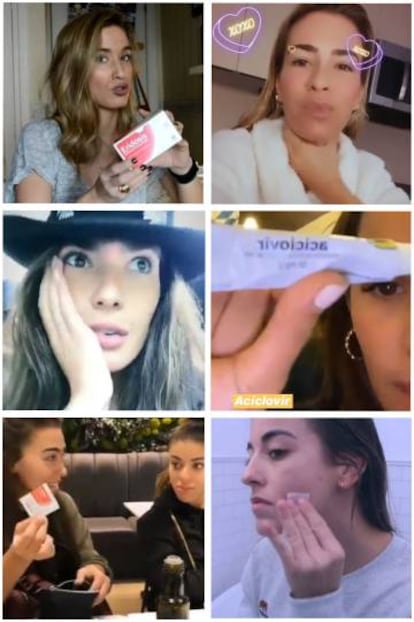Spain cracks down on influencers who are bad for your health
The Health Ministry is working to eliminate videos on social networks such as Instagram that promote drugs and treatments that should only be available on prescription

A few months ago, Spain’s pharmaceutical association CGCF noticed that demand for a specific brand of facial wipes used to treat acne was soaring, after pharmacies began calling in about it.
The sudden rise in interest was caused by several videos posted by social media influencers with hundreds of thousands of followers. These individuals had recommended the product, which is in fact an antibiotic that requires a medical prescription. Spanish legislation strictly restricts the advertising of such medication, as its indiscriminate use can cause health problems.
This is not the first time that medication has been pushed on the internet as though it were a book or a bottle of perfume. Guillermo Martín Melgar, a pharmacist, has been observing how some of these opinion shapers, especially those from the world of fashion and lifestyle, routinely tell their followers to use products that should only be prescribed by trained health professionals.
In September, Martín Melgar decided to make a list of all such recommendations that he came across, and he posted the results on his Twitter account. The list kept growing: a pomade used for infections, an antiviral drug to treat some forms of herpes, another acne treatment, guidelines on how to take flu medication so it won’t affect one’s sleep patterns, and more.
One of the problems is that they don’t take criticism from professionals. They respond with insults or by blocking us
Guillermo Martín Melgar, pharmacist
The CGCF filed a complaint with the Health Ministry, which has moved into action. At first the investigation focused on YouTube, which the ministry contacted to let it know that Spanish legislation prohibits encouraging the consumption of prescription drugs, while over-the-counter products are subject to strict rules that force advertisers to clearly indicate that it is medication and that a health professional should be consulted to resolve any doubts.
“The platform was asked to immediately remove the content, or else make access impossible,” said a ministry spokeswoman, adding that it was a “general requirement” and that no specific videos were identified.
In late December, Google (which owns YouTube) responded with a message expressing a willingness to cooperate with Spanish authorities and take down any content in violation of the law. But the company has told this newspaper that this will only happen when they receive a list of specific videos, which will be examined one by one to check whether they violate YouTube’s terms and conditions.
But YouTube is not the only place where prescription medication is being promoted. Martín Melgar says that most of this content is also found on Instagram. The ministry said that it will work to take down these videos on any social media platform, and that it is working with doctors’ and pharmacists’ associations to deal with the problem. The latter are proposing committees to analyze content and to raise awareness among businesses and citizens.
When faced with a barrage of criticism for recommending prescription drugs – she told followers how a cream for skin infections took away “a really big little ball” from her ear in just two days – the Instagrammer Marta Carriedo was unconcerned.
A similar pattern
All the influencers detected by both the CGCF and Guillermo Martín Melgar follow a similar pattern: they are young women who share fashion and beauty advice. “They are bloggers who recommend all kinds of things, from clothes and creams, to medication, typically for beauty purposes,” says Martín Melgar.
“One of the problems is that they don’t take criticism from professionals. They respond with insults or by blocking us. I’ve been told that I have no idea, that they can talk about whatever they please, or that pharmacists are a mafia group,” he adds.
Lorea Bagazgoitia, of the Spanish Academy of Dermatology and Venereology, has had similar experiences. “Once the videos are detected we try to correct the situation, but we are met with haughty responses.”
EL PAÍS unsuccessfully tried to reach some of these influencers for comment.
“Who cares if it required a prescription, it worked for me. It’s like if I get strep throat and my doctor prescribes a medication; evidently I’m going to tell you if there’s one that works worse than another,” she said. “Oh well, it’s more of the same. I’m so over this kind of shit, I really don’t care.”
A lot of the videos are no longer available online, either because their authors took them down, or because they were created specifically as short-lived Instagram “stories,” which last only a few hours.
Ana López-Casero, of the CGCF, explains that at the heart of the problem is people’s lack of knowledge about medication. “Many people view it as just another consumer product, like clothes or records, but that’s not what it is,” she says. “We don’t want to criminalize these influencers, surely their intentions are good, but the rules for promoting medication are very strict, and they should also be followed on the new channels.”
But none of this happens when influencers make their recommendations. Although health professionals consulted by this newspaper said that the products pushed by these social media starlets do not generally pose a big risk to individual human health, improper use of antibiotics can create resistance to drugs, a public health problem of great concern to the international community. Overusing antibiotics can diminish their effectiveness against bacteria.
“We are spending a lot of money on awareness campaigns and on resources to make people use antibiotics wisely, only when they are necessary and in the right doses. With videos like these, which are viewed by hundreds of thousands of people, the effort could be in vain,” says López-Casero. The World Health Organization (WHO) has estimated that antimicrobial resistance will cause 10 million deaths a year by 2050, more than cancer.
English version by Susana Urra.
Tu suscripción se está usando en otro dispositivo
¿Quieres añadir otro usuario a tu suscripción?
Si continúas leyendo en este dispositivo, no se podrá leer en el otro.
FlechaTu suscripción se está usando en otro dispositivo y solo puedes acceder a EL PAÍS desde un dispositivo a la vez.
Si quieres compartir tu cuenta, cambia tu suscripción a la modalidad Premium, así podrás añadir otro usuario. Cada uno accederá con su propia cuenta de email, lo que os permitirá personalizar vuestra experiencia en EL PAÍS.
¿Tienes una suscripción de empresa? Accede aquí para contratar más cuentas.
En el caso de no saber quién está usando tu cuenta, te recomendamos cambiar tu contraseña aquí.
Si decides continuar compartiendo tu cuenta, este mensaje se mostrará en tu dispositivo y en el de la otra persona que está usando tu cuenta de forma indefinida, afectando a tu experiencia de lectura. Puedes consultar aquí los términos y condiciones de la suscripción digital.
More information
Archived In
Últimas noticias
How Japan is trying to avert ‘digital defeat’
The complicated life of Francesca Albanese: A rising figure in Italy but barred from every bank by Trump’s sanctions
Half of Scotland is in the hands of 420 property owners
From digital curfews to blocking apps: How technology experts protect their children online
Most viewed
- Why we lost the habit of sleeping in two segments and how that changed our sense of time
- Pablo Escobar’s hippos: A serious environmental problem, 40 years on
- Trump’s obsession with putting his name on everything is unprecedented in the United States
- The Florida Keys tourist paradise is besieged by immigration agents: ‘We’ve never seen anything like this’
- Charles Dubouloz, mountaineering star, retires at 36 with a farewell tour inspired by Walter Bonatti











































